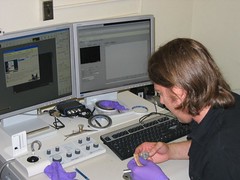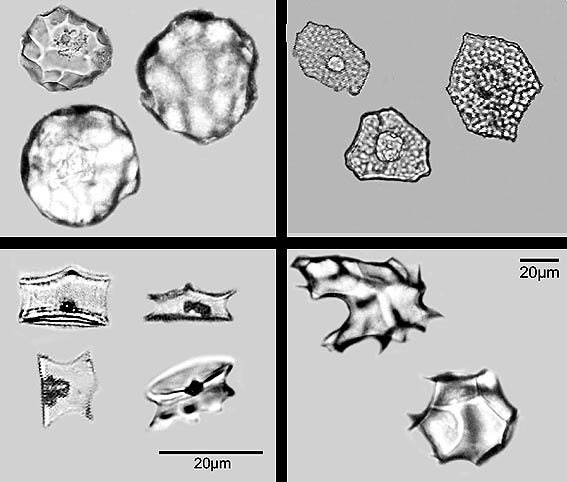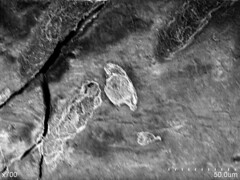 Holmes and I spent a morning last week with Jonathan Thomas, a Ph.D. student in the UI Department of Anthropology using Geoscience’s scanning electron microscope (SEM) to check the sloth teeth for phytoliths. Jonathan is an archaeologist studying Neolithic Iberia, and is the “go-to” guy in Anthropology for SEM work. This was just the first step—a quick non-destructive screening to check the condition of the teeth and determine the feasibility of further analysis. Results exceeded all expectations and several apparent phytoliths were observed. We were joined by Meghann Mahoney from the UI Museum of Natural History.
Holmes and I spent a morning last week with Jonathan Thomas, a Ph.D. student in the UI Department of Anthropology using Geoscience’s scanning electron microscope (SEM) to check the sloth teeth for phytoliths. Jonathan is an archaeologist studying Neolithic Iberia, and is the “go-to” guy in Anthropology for SEM work. This was just the first step—a quick non-destructive screening to check the condition of the teeth and determine the feasibility of further analysis. Results exceeded all expectations and several apparent phytoliths were observed. We were joined by Meghann Mahoney from the UI Museum of Natural History.
Many plants absorb silica from the ground water and redeposit it in their cell walls and intercellular spaces. Phytoliths, from the Greeek phyto (plant) and lithos (stone), are rock hard and highly abrasive. They provide structural support for plants and also serve to discourage herbivores and other attackers.
 Like concrete poured into a form, phytoliths take on the shape of their surrounding cells, varying with plant species and the type of tissue–bark, stem, fruit, etc. They can be used to help identify their host plants long after all the organic material around them has decayed. Archaeologists use phytoliths to track the domestication of corn and other crops. Paleoecologists look for them in deposits to help reconstruct ancient ecosystems.
Like concrete poured into a form, phytoliths take on the shape of their surrounding cells, varying with plant species and the type of tissue–bark, stem, fruit, etc. They can be used to help identify their host plants long after all the organic material around them has decayed. Archaeologists use phytoliths to track the domestication of corn and other crops. Paleoecologists look for them in deposits to help reconstruct ancient ecosystems.
Phytoliths become embedded in teeth by chewing, as we found aplenty (left). Bacteria can also cement them into tooth crevices. Extraction and identification of the phytoliths buried in a couple of our sloth’s teeth could provide some valuable insight into their diets, or at least the plants they ingested accidentally while munching on something nearby. That will entail scraping off the top layer of the tooth, dissolving the dentine and separating the plant-stones from the sand and grit to get accurate measurements and an all-around view. It promises to be a fruitful area for further study. Thanks to Jonathan for the lesson. . . . Dave
Bacteria can also cement them into tooth crevices. Extraction and identification of the phytoliths buried in a couple of our sloth’s teeth could provide some valuable insight into their diets, or at least the plants they ingested accidentally while munching on something nearby. That will entail scraping off the top layer of the tooth, dissolving the dentine and separating the plant-stones from the sand and grit to get accurate measurements and an all-around view. It promises to be a fruitful area for further study. Thanks to Jonathan for the lesson. . . . Dave









That’s great news. Keep up the good work guys.
– Pete